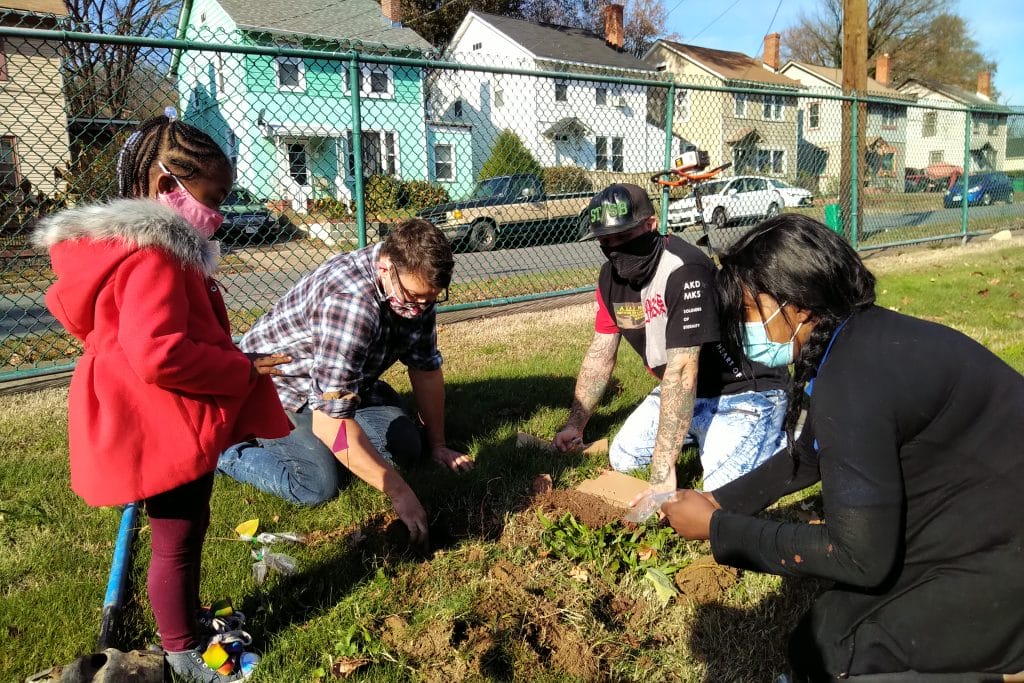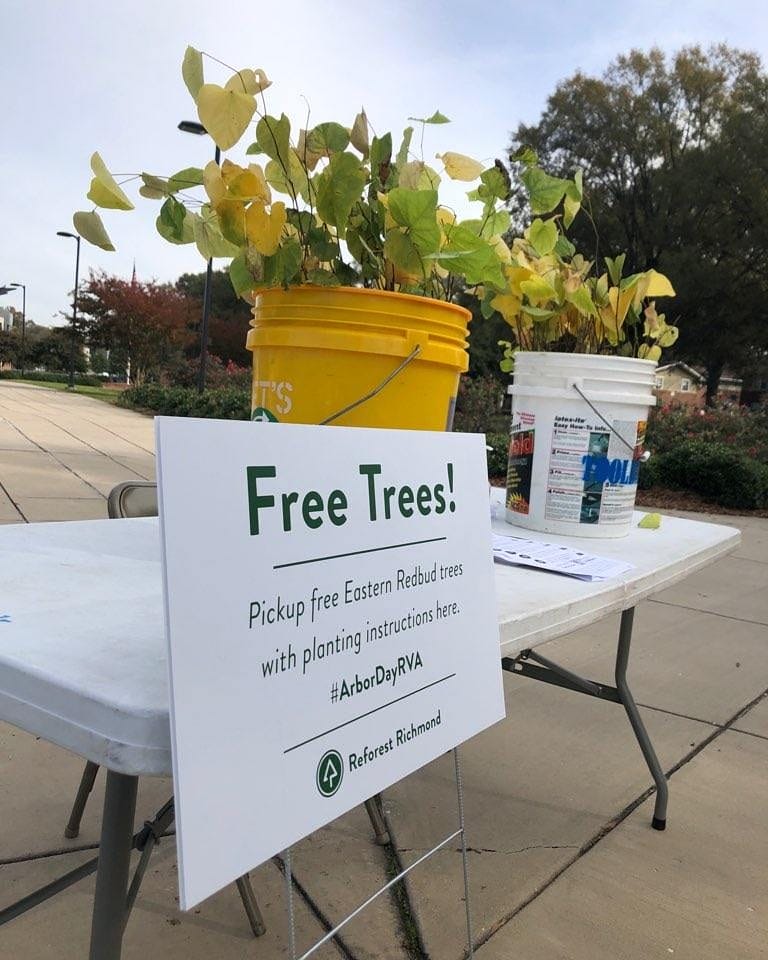Richmond environmental groups seek to address greenery gaps in minority neighborhoods

Groundwork RVA, Southside ReLeaf and Reforest Richmond volunteers plant trees at Swansboro Elementary School as a part of “Reforest RPS,” a community planting event for Richmond Public Schools, last November. Photo courtesy of Daniel Klein
Grace McOmber, Contributing Writer
Richmond residents were given the chance to bring home a new addition to their yards last fall in the form of a free Eastern redbud seedling, courtesy of the Richmond Tree Committee.
“We ended up giving away about 8,000 trees in about three weeks, which is kind of a stupidly big number,” RTC chair Daniel Klein said. “I thought people liked trees, but people love trees.”
Reforest Richmond, a campaign created by RTC, held the first “Arbor Day RVA” event last November with over 70 volunteers, Klein said. The event invited Richmond residents to bring home a new tree from 42 pickup sites throughout the city.
This event, along with the group’s other initiatives, was created to increase the number of healthy trees in Richmond and address systemic disparities in tree density. Low tree density can lead to a number of adverse health and environmental effects, especially in low-income or minority communities.
“It’s kind of the goal behind Reforest Richmond,” Klein said. “This is about a forest. It’s thinking ‘how do we get way more trees to healthfully, successfully grow and provide their benefits?’”
Klein and Reforest Richmond are currently planning a second annual Arbor Day RVA this fall, with hopes to give away even more trees. Klein said the organization is looking to incorporate more community planting events and educational workshops that focus on tackling inequalities in tree distribution.
“There are a lot of low-income folks, or people of color that have been historically disinvested in. We need to prioritize where we put our trees.” — Daniel Klein, Richmond Tree Committee chair
“Community conversations and listening sessions will be a big part of this,” Klein said. “The conversation is designed to be a very slow, forward conversation about ‘what’s the priority and how do we tackle it?’”
Reforest Richmond is aiming to achieve a 60% urban canopy, or the collective amount of trees, in Richmond by 2037. This goal falls under the Richmond 300 master plan, a blueprint for the city’s growth adopted by the Richmond City Council in December.
“It’s not designed to be a quick organization,” Klein said. “It’s designed to build really long-term solutions. Building a canopy takes time.”
According to Klein, RTC has five main goals — updating Richmond’s nearly 30-year-old tree ordinance, establishing a robust urban forestry commission, creating a tree inventory, employing an official urban forester for the city and conducting a new tree canopy assessment, which was last done in 2010.
“Reforest Richmond is the citizen forestry side of all of this,” Klein said. “Just trying to get people to think about it, to prioritize it, create opportunities where people can get free trees or plant trees. And just make it fun and a way for people to participate in climate justice.”
Increasing Richmond’s urban canopy has a number of benefits, Klein said. Trees are an effective method of reducing excess storm runoff by absorbing precipitation before it hits the ground, which can cause flash flooding, quicken erosion and allow for toxic chemicals to enter storm drains, Klein said.
Dense urban canopies provide an ecosystem for wildlife to thrive and naturally increase air quality. They also protect against the urban heat island effect, which occurs when tree density is low, causing the sun’s heat to be absorbed by roads, buildings and other infrastructure. It is then reemitted, causing high temperature pockets to form, according to the Environmental Protection Agency.
“It’s not hard to see that neighborhoods with more trees and more tree canopy have better air quality,” Klein said. “They’re capturing more emissions, just in the same way that they’re capturing and delaying more storm water.”
The disparities in tree density and quality throughout the city, according to Klein, are a direct result of racist laws and ordinances that have created gaps in the quality and quantity of trees in minority neighborhoods.
Tree density in formerly redlined neighborhoods is significantly lower than in other areas of Richmond, according to the 2018 Richmond 300 insight report. These areas subsequently have an increased vulnerability to urban heat, which can result in a 1-to-7 degree Fahrenheit difference in temperature, according to the EPA. These include the Gilpin, Jackson Ward, Randolph, Oak Grove and Church Hill neighborhoods, among others, according to a 2020 New York Times report.

Klein said there is a direct correlation between low tree canopy density and emergency calls for heat-related emergencies, such as heat strokes and asthma attacks.
“There are a lot of low-income folks, or people of color that have been historically disinvested in,” Klein said. “We need to prioritize where we put our trees. We should put them everywhere, but we should start there.”
Klein said trees in these areas are not properly maintained, leading to infrastructure and property damage, such as cracked sidewalks due to overgrown roots and falling branches.
“Building canopy comes second to building back trust,” Klein said. “People have to trust the city to take care of this stuff and not neglect them.”
Laura Greenleaf, a volunteer with the James River Park System and founder of the invasive plant task force, said neglected trees can fall victim to invasive species that damage their health and weigh down their branches, increasing the risk of them falling down.
“I’m all about planting trees, as long as they’re native trees, and certainly in areas that don’t have them,” Greenleaf said. “But we have to couple that with preserving our existing mature trees.”
South Richmond is one area affected by low-density and low-quality tree canopy. Southside residents have higher rates of chronic illnesses, including double the rate of asthma, when compared to those living in the West End, a wealthier suburb, according to the 2018 Richmond 300 insights report.
“Southside residents have a 20 years shorter life expectancy than people who live north of the river in the West End,” Sheri Shannon, co-founder of Southside ReLeaf, said. “Not everyone is able to access a green space within 10 minutes of walking. We have crumbling infrastructure, unsafe and unstable housing. It’s a combination of systemic failures.”
Southside ReLeaf, which works to achieve environmental equity and sustainability in South Richmond, collaborated with Reforest Richmond to launch Arbor Day RVA last November. The organizations continue to work together under the common goal of expanding the urban canopy in the city.
“It’s not just planting new trees, it’s being able to be intentional with our decisions and with allocating resources,” Shannon said. “So it’s an equity thing as well. You notice certain parts of the city have very well-maintained urban canopy compared to other parts of the city.”
Shannon said incorporating historically marginalized communities into the decision making process for urban forestry is essential for the success of organizations like Southside ReLeaf.
“We want to be able to help create the space where folks can actually show up and say ‘this is what I want to see in our neighborhood,’” Shannon said. “We want to pass the mic.”



